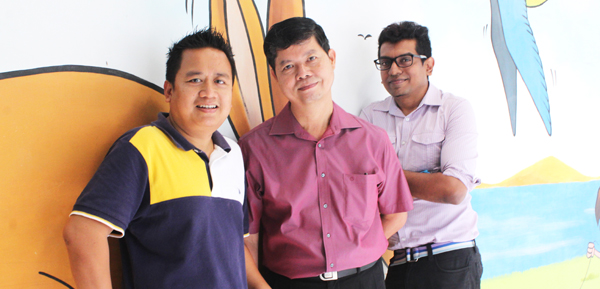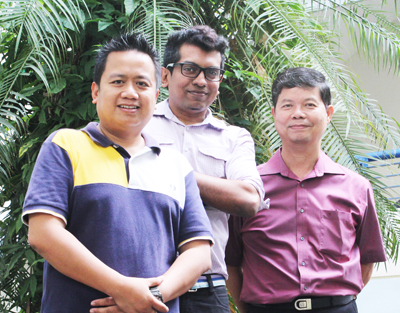Why Singapore’s English Teachers Should Embrace Singlish, Not Fight It
Is it time for Singaporean educators to embrace Singlish as a legitimate learning tool? What the Research […]
Read More
A successful student is a motivated one. We find out from a group of Senior Teachers how they use differentiated instruction to help all students stay motivated.
All learners like the taste of success, be it a secondary school student learning the facts of History or a primary school pupil studying Math.
This innate drive in students to succeed is something that teachers can harness to motivate them. How should teachers do it?

“In order to give students success, we need to design our lessons in a certain way that they can succeed,” says Senior Teacher Mr Elamaran Natarajan, who teaches History at Holy Innocents’ High School.
Together with three other Senior Teachers that he met at the NIE Senior Teachers Programme, Elamaran looked into how differentiated instruction can help with that.
Mr Tan Keok Kee, who teaches Math at Jurongville Secondary School, shares that differentiated instruction recognizes that teaching should address three aspects of students’ needs: their learning preferences, interests and levels of readiness.
With that in mind, teachers will better understand that students have different abilities and interests. While some will do well for a particular topic, others might not.
“Those who do fail miserably will start to think it is their fault that they failed. And from there on, their motivation is totally wiped out, because they are not doing well,” says Elamaran.
To avoid such scenarios, teachers can find out more about students’ different learning preferences.
 Are your students visual or auditory learners? Or do they learn better by reading or through hands-on activities?
Are your students visual or auditory learners? Or do they learn better by reading or through hands-on activities?
“Because of our different strengths, we need to learn in different ways,” says Elamaran. By administering a free questionnaire called VARK (which stands for Visual, Auditory, Reading/Writing, Kinesthetic) and through observation, the teachers were able to gauge how their students could learn more effectively, says Mr Zaini Bin Daud, who teaches Foundation Math at Blangah Rise Primary School.
Keok Kee notices another benefit of this exercise. “The students realize that the teachers care for them enough to find out how they prefer to learn. This is already a plus point to them, so they are more keen to learn and more attentive.”
From there, teachers can then modify their teaching strategies to suit their students’ preferences.
“The learning points for our students are exactly the same. But how we reach the learning point is different,” Elamaran says.
“Kinesthetic students do a trail and go around the whole school. The higher ability students and the readers; they can do research in the library. And another group of students can watch a video on the same topic.”
However, the teachers note that it is also a good idea to teach a topic in different ways to the whole class.
“When I teach, I try to figure out how to present the same concept in four different ways. Then, I will teach it to the whole class rather than focus on the groups separately,” says Keok Kee. “This will help students to level up on the learning preferences that they are not so strong in.”
Because of our different strengths, we need to learn in different ways.
– Elamaran Natarajan, Holy Innocents’ High School
The teachers also take into account the readiness of their students in a particular subject or for a topic.
In Zaini’s class, many pupils struggle to read. He plans his Foundation Math lessons carefully so that everyone is learning at a comfortable pace.
For weaker pupils, he gives them a separate set of worksheets or tasks that he knows they can manage.
“This approach lets them celebrate small, personal successes. When they succeed in doing some tasks, they get so motivated and want to do more,” says Zaini. “And this is coming from a group whose self-esteem can be very low!”
“It’s like a game for them,” he elaborates. “If they’re ready, we let them proceed to another level. Eventually, everybody will get the same worksheets, because everybody will be doing the same exam. Only the approach and speed differs from pupil to pupil.”
No doubt, it is more time-consuming to teach in this way, but Zaini finds a sense of satisfaction in deviating from the one-teaching-strategy-fits-all approach.
To find out if the differentiated instruction approach works, Elamaran did a survey with his students. In particular, he wanted to know if it did motivate them. “I think all of them were motivated due to the fact that they now understand something and are able to do something about the topic that they really found difficult in the past!”
Keok Kee also notes a big improvement in student performance in his “project” class of Secondary 4 Normal (Academic), compared to the control class.
As for Zaini, his pupils are now trying harder. Instead of leaving lots of blanks in their worksheets, they are providing more “promising” answers. The struggling readers are also improving. “It’s moving forward a little bit; I also want to celebrate my own little successes to motivate myself!” he says.
Even though these teachers are teaching different subjects at different levels, they were all able to use differentiated instruction to make a difference in their students’ learning. To them, this is proof and encouragement that teachers should never be afraid to try something new. As Elamaran sums it up, “We must always find out new ways to attain the goals of education and not just be happy with what we have now.”